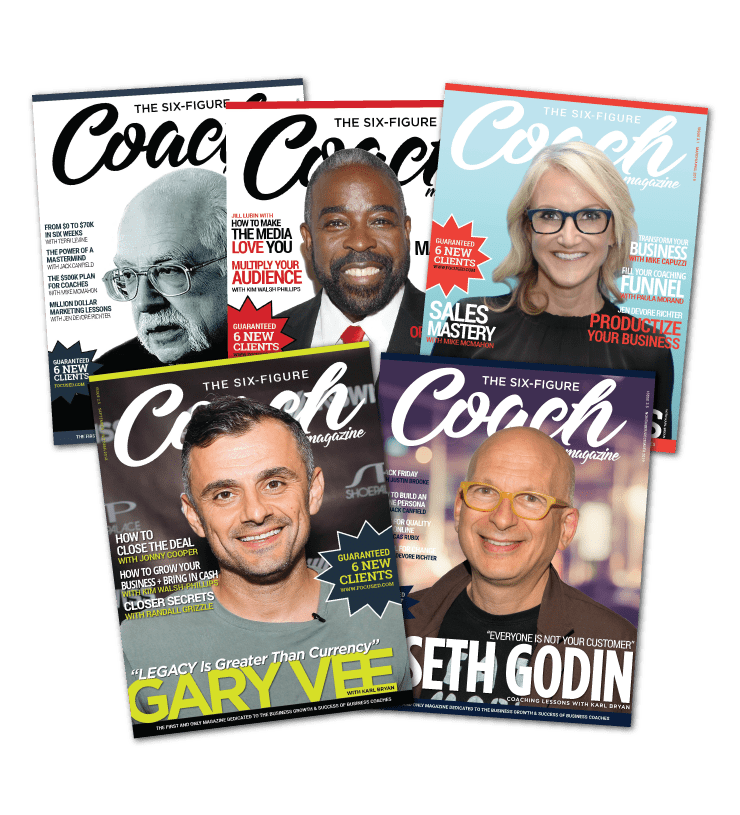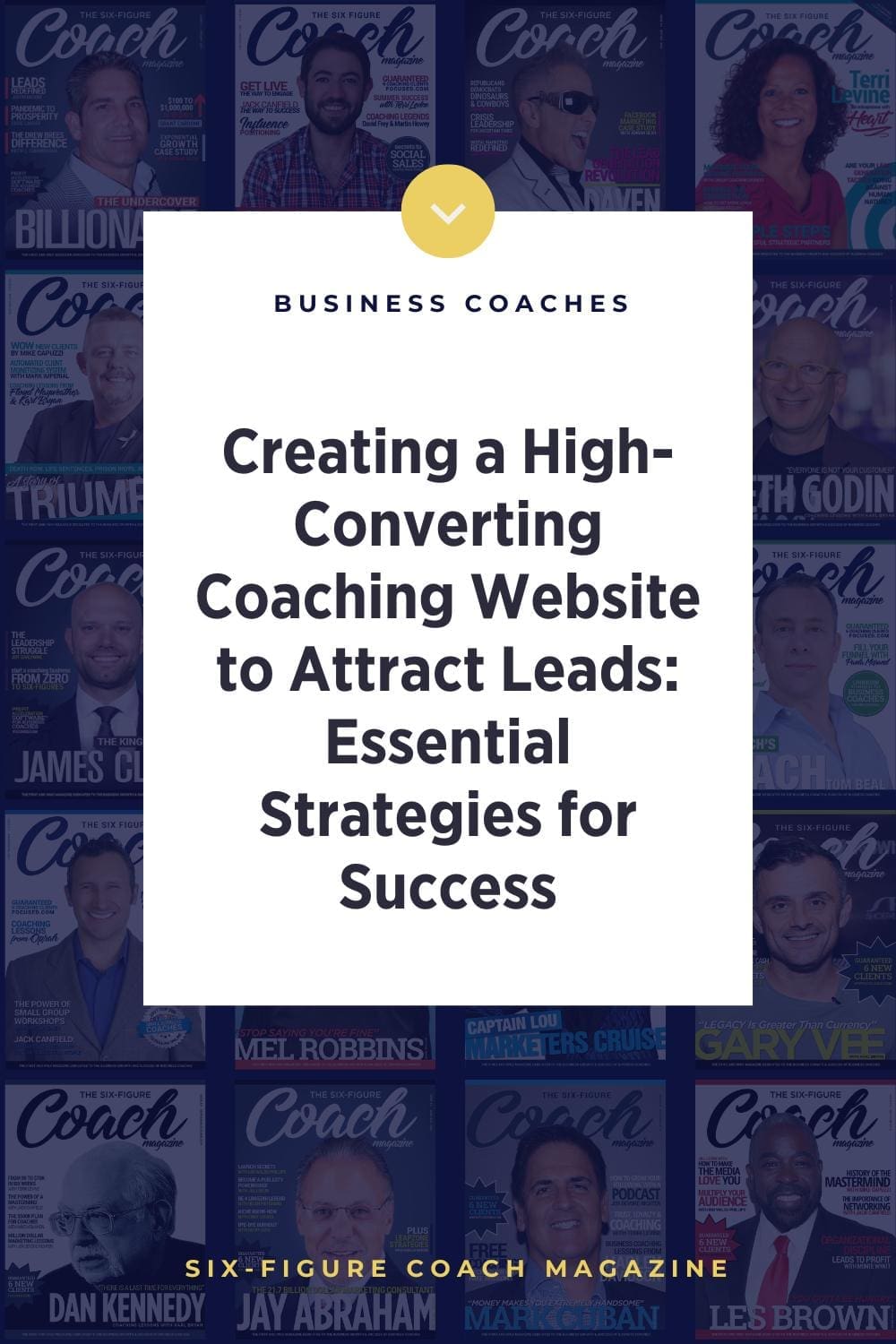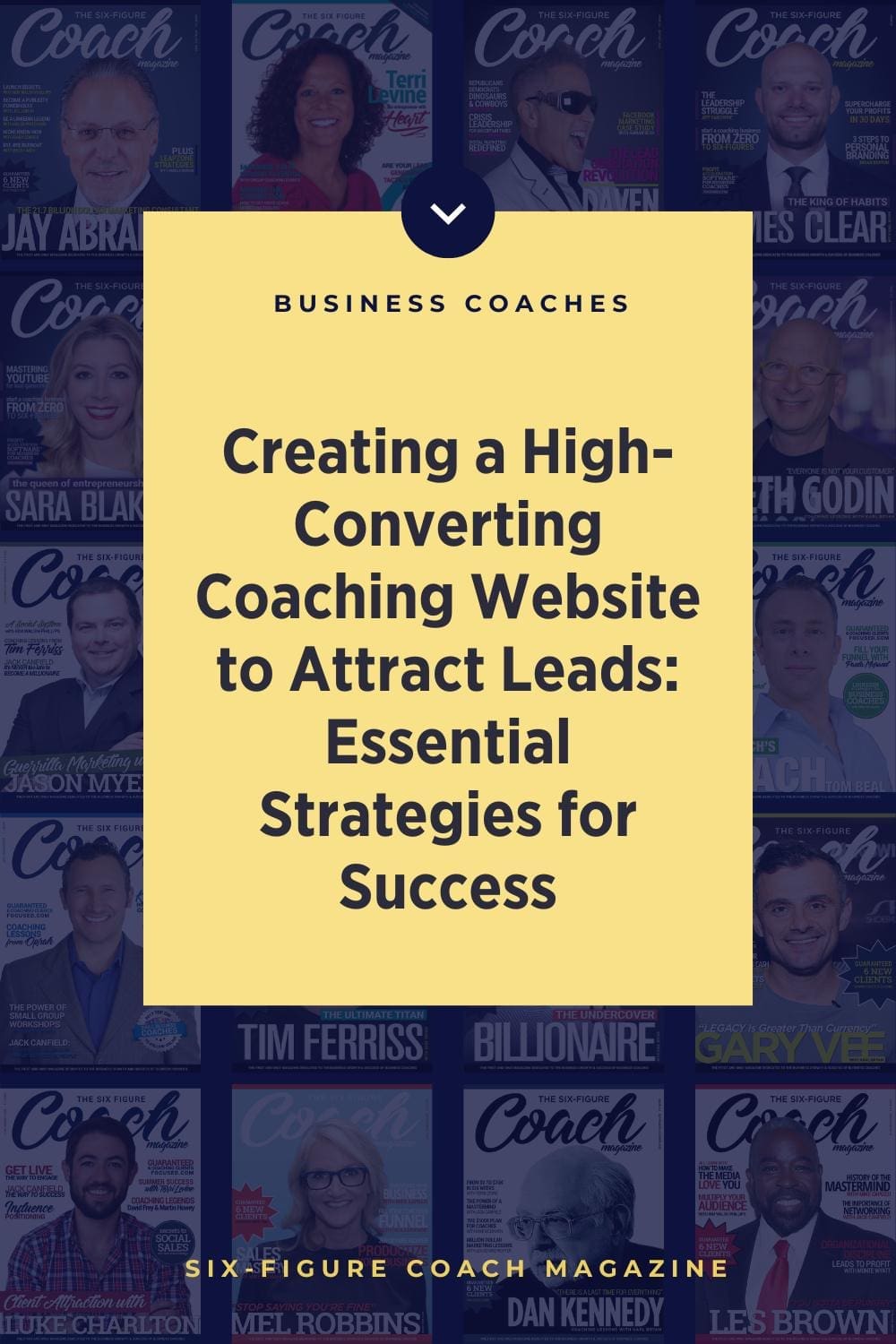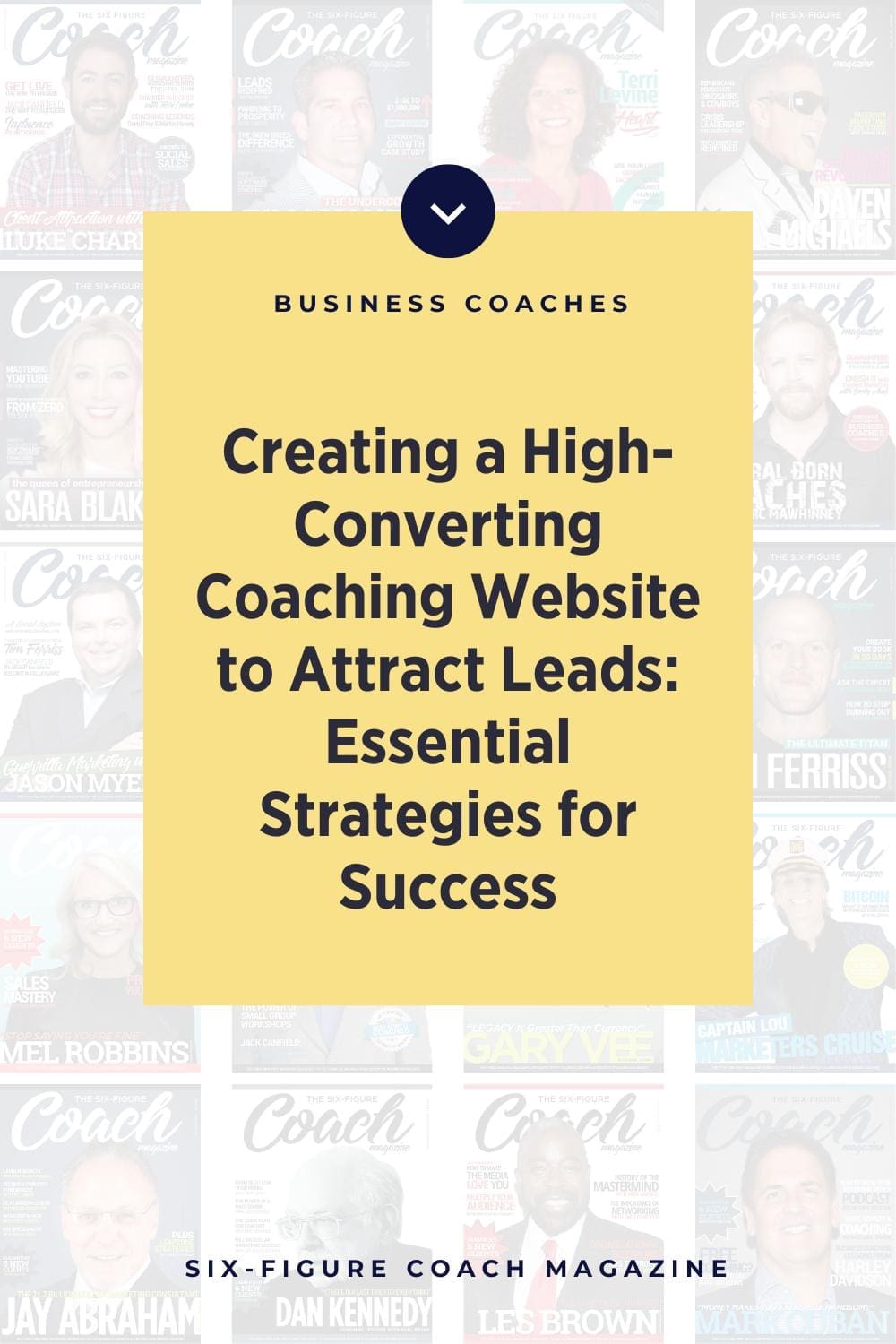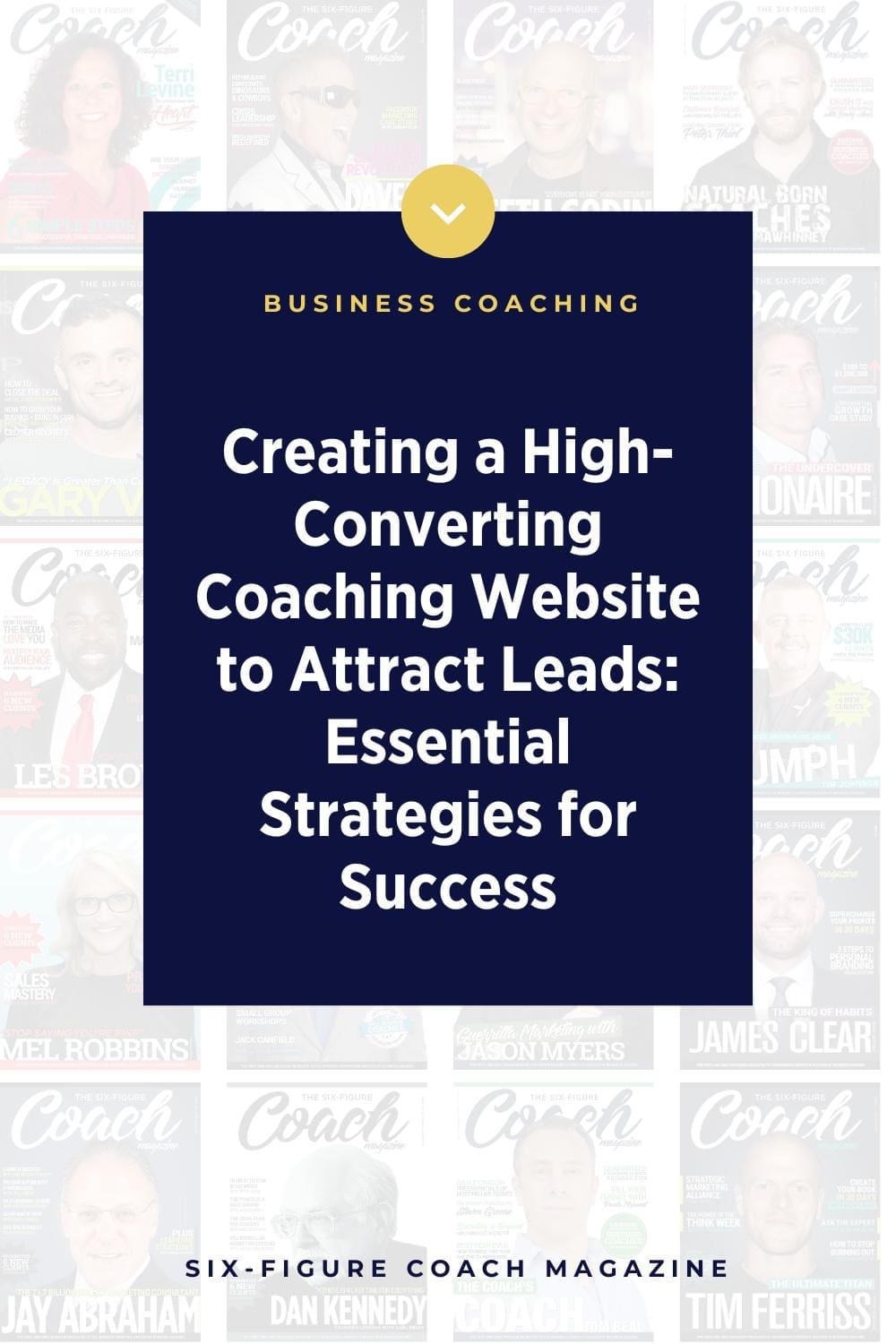Creating a High-Converting Coaching Website to Attract Leads: Essential Strategies for Success
A well-designed coaching website can make a big difference in attracting new clients. It serves as a digital storefront, showcasing your expertise and services to potential leads.
A high-converting coaching website should have clear messaging, an easy-to-use layout, and compelling calls-to-action. These elements help visitors understand what you offer and take the next step towards becoming clients.
Effective coaching websites also include social proof, such as testimonials or case studies. This builds trust with potential leads and shows the value of your coaching services. By focusing on these key aspects, coaches can create websites that turn visitors into paying clients.
Defining Your Coaching Brand
A strong coaching brand sets you apart and attracts ideal clients. It combines your unique value with a clear understanding of who you serve. Let’s explore how to craft your brand’s core elements.
Crafting Your Value Proposition
Your value proposition tells potential clients why they should choose you. It highlights your unique strengths and the results you deliver. Think about what makes your coaching special. Do you have a proven method? Specific expertise? A unique background?
Write a short statement that captures your key benefits. For example: “I help busy professionals find work-life balance in 90 days or less.” Keep it clear and specific. Focus on outcomes clients care about.
Test your value proposition with current clients or colleagues. Ask if it resonates and reflects what you offer. Refine it until it feels authentic and compelling.
Identifying Your Target Audience
Knowing your ideal clients helps you tailor your message and offerings. Start by picturing your best clients. What do they have in common? Consider factors like:
- Age range
- Career stage
- Goals and challenges
- Values and interests
Create a detailed profile of your target client. This helps you speak directly to their needs in your marketing. It also guides your website design and content choices.
Don’t try to appeal to everyone. A focused approach attracts more of the right clients. Your brand becomes stronger when it speaks clearly to a specific group.
Designing Your Website
A well-designed coaching website is key to attracting leads and turning visitors into clients. The right tools, templates, and visual elements can make your site stand out and boost conversions.
Selecting the Right Website Builder
Choose a website builder that fits your skills and needs. Many options offer easy-to-use drag-and-drop interfaces. These tools let you create a site without coding knowledge. Look for builders with coaching-specific features like appointment scheduling and payment processing.
Popular choices include Wix, Squarespace, and WordPress. Each has its strengths. Wix is user-friendly for beginners. Squarespace offers sleek designs. WordPress provides more customization options.
Pick a builder that grows with your business. Make sure it can handle increased traffic and new features as your coaching practice expands.
Utilizing Effective Website Templates
Start with a template designed for coaches or consultants. These layouts are made to showcase your services and build trust. Look for templates with clear calls-to-action and space for client testimonials.
Customize the template to match your brand. Change colors, fonts, and images to create a unique look. Keep the design clean and simple. Too many elements can distract visitors from your message.
Test your site on different devices. A good template should look great on both computers and smartphones. This ensures a smooth experience for all potential clients.
Incorporating High-Quality Images & Video Content
Use professional photos and videos to make your site more engaging. High-quality visuals can help build trust and show your expertise. Include a professional headshot and images of you working with clients.
Create short videos to introduce yourself and explain your services. This personal touch can help visitors connect with you. Keep videos brief and to the point. Aim for 1-2 minutes maximum.
Optimize your images and videos for fast loading times. Large files can slow down your site and frustrate visitors. Use compression tools to reduce file sizes without losing quality.
Creating Engaging Content
Compelling content is key to attracting and converting coaching clients. A well-designed website with valuable information helps build trust and showcase expertise.
Developing a User-Friendly Homepage
The homepage should grab attention quickly. Use a clear headline that states the coach’s main offer. Add a brief description of services and target audience. Include a prominent call-to-action button for easy sign-ups.
Add social proof like client logos or testimonial snippets. Keep the design clean and uncluttered. Use high-quality images that represent the coach’s brand.
Make sure the homepage loads fast on all devices. Include easy navigation to other important pages. A user-friendly homepage helps visitors find what they need quickly.
Showcasing Coaching Programs and Packages
Create a dedicated page for coaching offerings. List different program options with clear descriptions. Include pricing information when possible.
Use bullet points to highlight key features and benefits. Explain who each program is best suited for. Add a clear call-to-action for each package.
Consider offering a free initial consultation. This can help potential clients get to know the coach. It also allows coaches to assess if the client is a good fit.
Incorporating Client Testimonials and Case Studies
Add a testimonials page to the website. Include short quotes from happy clients. Use full names and photos when possible to increase credibility.
Create detailed case studies of client success stories. Describe the client’s initial challenge and the coaching process. Highlight the positive outcomes achieved.
Sprinkle testimonials throughout the site, not just on one page. This reinforces social proof as visitors browse. Video testimonials can be especially powerful.
Blogging as a Marketing Tool
Start a blog and post useful content regularly. Write about topics that interest potential clients. Share expert tips and insights related to coaching.
Use keywords in blog posts to improve search engine rankings. Add social sharing buttons to each post. This helps spread content to new audiences.
Include a call-to-action at the end of each blog post. This can guide readers to sign up for coaching or join an email list. Blogging builds trust and shows expertise over time.
Optimizing for Search Engines
Search engine optimization helps coaching websites get found online. Good SEO practices boost visibility and attract more potential clients to a coach’s site.
Understanding SEO Strategies
SEO aims to improve a website’s ranking in search results. This makes it easier for people to find a coach online. Key SEO strategies include using relevant keywords, creating quality content, and building backlinks.
Coaches should focus on local SEO if they work with clients in a specific area. This means including location-based keywords and creating local business listings. Mobile optimization is also vital, as many people search on phones or tablets.
Regular website updates signal to search engines that a site is active and relevant. Fresh blog posts, new service pages, or client testimonials can boost SEO efforts.
Performing Keyword Research
Keyword research uncovers terms potential clients use when searching for coaching services. Tools like Google Keyword Planner or SEMrush help find popular and relevant keywords.
Coaches should target a mix of short and long-tail keywords. Short keywords are broad terms like “life coach.” Long-tail keywords are more specific, such as “career transition coach for executives.”
It’s important to check keyword difficulty and search volume. This helps coaches pick terms they can realistically rank for. They should also look at what keywords competitors are using.
Implementing On-Site SEO
On-site SEO involves optimizing individual web pages. This includes using keywords in page titles, headers, and meta descriptions. Coaches should write clear, descriptive URLs for each page.
Content should be high-quality and include target keywords naturally. Images need alt text that describes them and includes relevant keywords when possible.
Site speed is a key ranking factor. Coaches should compress images, use caching, and choose a fast hosting provider. A secure site (HTTPS) is also important for SEO and user trust.
Internal linking helps search engines understand site structure. Coaches should link between related pages on their site. This guides visitors to more information and keeps them on the site longer.
Strengthening Online Credibility
A strong online presence builds trust with potential clients. It showcases expertise and highlights positive feedback from past customers.
Building a Strong Personal Brand
A personal brand sets coaches apart from competitors. Use a professional headshot and consistent branding across platforms. Create a clear tagline that sums up your unique value. Share your story and background to connect with visitors.
Highlight certifications and training to show expertise. List any speaking engagements or published works. A well-crafted “About” page gives insight into your coaching style and approach.
Regular blog posts or videos demonstrate knowledge in your field. They also improve search engine rankings. Social media profiles should align with your website’s branding and message.
Displaying Social Proof Through Reviews and Ratings
Client testimonials build credibility quickly. Feature short quotes from satisfied customers on the homepage. Include full reviews on a dedicated testimonials page.
Use a mix of text, video, and audio testimonials for variety. Ask clients to rate their experience on trusted review sites. Display these ratings prominently on your website.
Case studies show real results from your coaching. They tell the story of a client’s journey and success. Include specific outcomes and metrics where possible.
Logos of companies or well-known clients you’ve worked with can impress visitors. Awards or media mentions also boost credibility. Display these trust signals throughout your site.
Enhancing User Experience
A well-designed coaching website puts the user first. It focuses on making visitors feel welcome and helps them find what they need quickly.
Ease of Navigation
Simple menus and clear labels make websites easy to use. Put important links in the main menu. Group similar pages together. Use descriptive names for menu items.
A search bar helps visitors find specific info fast. Place it in a visible spot, like the top right corner.
Add a clear call-to-action (CTA) on each page. This guides users to take the next step. Examples include “Book a Call” or “Sign Up for Newsletter”.
Ensuring Mobile Compatibility
More people browse on phones than computers. A mobile-friendly site is a must. Use responsive design to make your site look good on all devices.
Test your site on different phones and tablets. Check that text is readable and buttons are easy to tap. Make sure images resize correctly.
Consider a “mobile-first” approach when designing. This means starting with the mobile version, then adding features for larger screens.
Fast Loading Times
Slow sites frustrate visitors and hurt search rankings. Aim for load times under 3 seconds. Use tools like Google PageSpeed Insights to check your site speed.
Optimize images by compressing them and using the right file types. Large images slow down pages a lot.
Use a content delivery network (CDN) to serve files faster. This stores your site on servers around the world. Visitors get content from the closest server.
Minimize the use of plugins and scripts. Each one adds load time. Only keep what you really need.
Leveraging Social Media and Email Marketing
Social media and email marketing are powerful tools for coaches to attract leads and grow their business. These platforms help build relationships with potential clients and showcase expertise.
Integrating Social Media Platforms
Coaches should focus on key social media platforms where their target audience spends time. Create engaging content that offers value to followers. Share tips, insights, and client success stories. Use hashtags to increase visibility. Post consistently to stay top-of-mind with potential clients.
Consider using live videos or stories to give followers a behind-the-scenes look at your coaching practice. Respond promptly to comments and messages to build trust. Collaborate with other professionals in your field to expand your reach.
Building an Email Subscriber List
An email list is a valuable asset for coaches. Offer a free resource, like an e-book or mini-course, in exchange for email addresses. Place sign-up forms on your website and social media profiles.
Send regular newsletters with helpful content to keep subscribers engaged. Share success stories, coaching tips, and upcoming events. Segment your list based on interests or needs to send targeted messages.
Use automation to welcome new subscribers and nurture leads. Track open rates and click-throughs to improve your email strategy over time.
Creating Effective Call to Action (CTA)
A strong call to action guides potential clients to take the next step. Use clear, action-oriented language in your CTAs. Examples include “Book a Free Consultation” or “Download Your Free Guide.”
Place CTAs prominently on your website and in email campaigns. Use contrasting colors to make them stand out. Test different wording and designs to see what works best.
Create a sense of urgency with limited-time offers. Make sure the CTA leads to a user-friendly landing page or booking system. Follow up promptly with anyone who takes action.
Monitoring and Improving Conversion Rates
Tracking website performance and making data-driven improvements are key to maximizing leads. Regular analysis helps identify what’s working and what needs tweaking on a coaching website.
Using Analytics for Website Insights
Google Analytics is a powerful tool for understanding visitor behavior. It shows which pages attract the most traffic and where people spend their time. Coaches can see which content resonates with potential clients.
Set up goals in Analytics to track specific actions, like form submissions or newsletter sign-ups. This helps measure the effectiveness of calls to action.
Look at bounce rates to see if visitors quickly leave certain pages. High bounce rates may signal a need for better content or design on those pages.
A/B Testing for Optimization
A/B testing compares two versions of a webpage to see which performs better. Test different headlines, images, or button colors to find what leads to more conversions.
Start with small changes and test one element at a time. This makes it clear which change caused any improvement in results.
Use tools like Optimizely or Google Optimize to run tests. These platforms make it easy to create variations and measure outcomes.
Tracking Client Engagement and Feedback
Monitor how visitors interact with your site. Heat maps show where people click and how far they scroll. This info helps place important content where it’s most likely to be seen.
Use surveys to gather direct feedback from site visitors. Ask what they’re looking for and if they found it easily. This input can guide future website improvements.
Check your site’s loading speed regularly. Slow sites frustrate visitors and hurt conversions. Tools like GTmetrix can identify speed issues and suggest fixes.
Conclusion
A high-converting coaching website can make a big difference in attracting leads. It’s important to focus on key elements that grab attention and build trust.
Clear messaging helps visitors understand what you offer. A strong call-to-action guides them to take the next step.
Professional design and easy navigation keep people on your site. Showing your expertise through content proves your value.
Client testimonials and case studies provide social proof. Offering free resources builds goodwill and captures contact info.
An optimized website that loads quickly on all devices is crucial. Regular testing and tweaking based on data helps improve results over time.
With these elements in place, your coaching website can become a powerful tool for growing your business. It will attract more leads and turn them into clients.
You may also like
Many Paths to Success: The Tools and Systems That Power Top Business Coaches
Explore the many tools, programs, and paths business coaches use to succeed — and see why Focused.com’s Profit Acceleration Software™ is the ultimate system for growth and client results.
The Three Unbreakable Pillars of Business Coaching Success
Discover the three unstoppable strategies every business coach needs—lead generation, conversion, and fulfillment—to build a powerhouse coaching practice. Book a call to learn more.
The Power of Cloning: Why Reinventing the Wheel is Killing Your Coaching Business
Discover why cloning proven business models and strategies is the ultimate shortcut to growing your coaching business, and how you can take action today.
